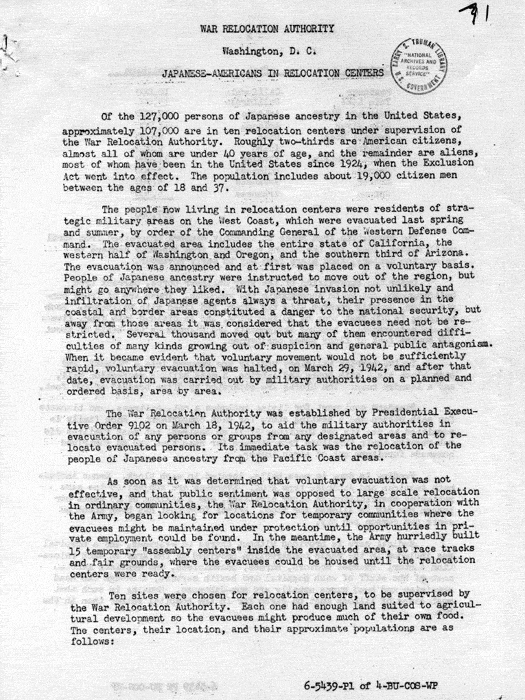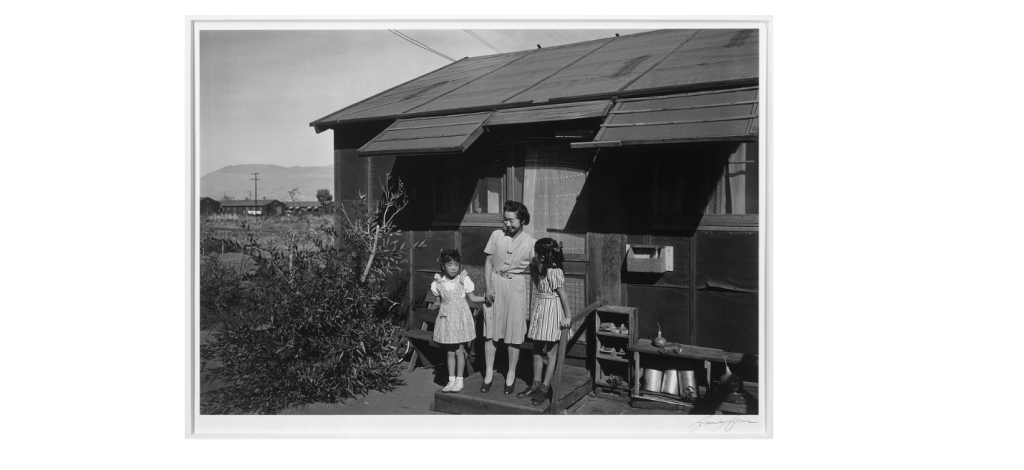History of Tension:
California’s long standing negative relationship with Asian Americans beginning with the Gold Rush of 1848 rapidly declined into the 20th century. The affair worsened after Americans claimed that the Asian immigrants were taking their jobs and business. In retaliation they committed violent acts against them. This further intensified when the United States began supporting the Allies in World War II, one of their main opponents was Japan, an axis power. A sense of patriotism caused backlash against the Japanese American population (Foner 2016, 891). The bombing of Pearl Harbor was a big enough push for legislative lawmakers to back the President on Executive order 9066.
F. D. R. and Executive Order 9066:
President Franklin Delano Roosevelt drafted and passed Executive Order 9066 on February 19th in 1942, nearly two months after the bombing of Pearl Harbor. The motive of the document was to eliminate the threat of foreign spies on American soil. The flaw of this act was it targeted an unrelated population of people of the same race. Most Japanese Americans had nothing to do with the bombing of Pearl Harbor, but because they were of Japanese descent their rights were stolen. At the expense of many this order was created to weed out the few possible spies of the hundred thousand Japanese Americans settled on the west coast. FDR explains that he has the authority to instate this, but is not entirely in support or opposition of it (Roosevelt 1942, Executive Order 9066). Under Executive Order 9066 any Japanese Americans could be placed in an internment camp if it was suspected they were of Japanese origin. No documentation or physical proof of ancestry was needed.
Inconsistency with Order 9066 and Proof of Malicious Intent:
The face of Executive Order 9066 was to remove Japanese spies, but, it’s subtle intent was highly racist and schemed to segregate the races of the west coast. Proof of racist objective can be seen in the fact that internment camps weren’t established in Hawaii where a high number of Japanese Americans resided. In Hawaii the economic system was absolutely based off the labor of Japanese immigrants. If internment camps subsisted in Hawaii the economy would have crashed. Of the 158,000 Japanese Americans living in Hawaii only 2,000 were imprisoned (Cohen 2011, Treatment of Japanese-Americans in WWII Hawaii Revealed in Article). The population of Japanese Hawaiians was significantly higher than the number of Japanese Americans on the west coast but the amount of imprisoned persons was higher in California. Common sense would dictate in the place where the terrorist bombing took place, and where a larger population of Japanese lived harsher consequences would be inflicted if the executive order was to accomplish its true goal. This source displays the dysfunction, and obscure goal of internment camps. As well as it goes to show the only real reason they were instituted was for a sense of peace in the minds of white Americans.

War Relocation Flyer from 1942 (Truman 1942, Japanese-Americans in Relocation Center)
Japanese-Americans in Relocation Centers is a report that exhibits hard evidence that Japanese Americans were forced into internment camps, stating that voluntary evacuation wasn’t an option. It explains that the military bases were strategically placed, with a far enough distance in between them under the circumstances of a revolt the rebellion should easily be squashed. It also accounts for the amount of the male population which is between the ages of 18 and 37, roughly 19,000 people (Nation Archives 2018, Japanese Relocation During World War II). This age range provides the largest threat to the United States and military as men at this age would be the strongest and most able to overthrow their American oppressors. This age group happens to be the same as the United States draft age range. The report repeatedly explains the threat that the Japanese pose, even though the entire population they imprisoned and monitored for nearly a decade was composed of civilians. Not spies, or infiltrators.
Life in Internment Camps:
Frank H. Wu lived in an internment camp in America during the Second World War. Over his time there he kept in contact with his friend living freely in the states. They mailed each other letters regularly updating the other on events in their lives. In a letter Eddie he explains how he misses his home, the food, the freedom to leave and roam, and his friends. This letter provides evidence of the restrictions those living in internment camps dealt with. The Japanese Americans had filtered media content, their mail was inspected, they were unable to practice their religion freely, and were not allowed to speak in Japanese. Overall they had very little control over their lives similar to a prison today. Wu explains that there are two large groups within the camp, one encouraging boys to enlist in the United States army and the other opposing enlistment. Fighting for a country in which your rights are unrecognized is the exact same as African Americans joining the Civil War before they were granted freedom. The most striking thing he says is the way they were removed from their homes. FBI agents came to the door and entered without permission and forced them to exit (Wu 1944, Difficult Decisions during Wartime). This completely disregards all rights that they had. The FBI lacked a warrants, and the search was based off of the assumption that they were Japanese which constitutes as an unreasonable search.
Ansel Adams was an American photographer. In 1943 he visited the Manzanar Internment camp in Manzanar, California. He photographed the series Manzanar Relocation Center. He observed and documented the lives of Japanese American individuals and families residing in the camp. Much of his work shows the faces and day to day jobs of busy workers but this photograph displays a housing settlement. A mother and her two daughters stand on steps outside their temporary home, which Adams refers to as a dwelling, not a house.

Mrs. Yaeko Nakamura and her two children, Joyce Yuki (right) and Louise Tami (left), standing on the step at the entrance of a dwelling, Manzanar Relocation Center (Ansel Adams 1943)
Calling it a dwelling draws attention to the fact that the housing on internment camps were not the prisoner’s homes. Reinforcing the ideology that they are not imprisoned by choice. Forcing them to live in remote, military controlled area striped them of their rights, and was similar to the structure of the reservation camps imposed on Native Americans. It goes to show just how far the United States government is willing to go to remove a threat, even if it means exploiting their own citizens that they should be working to protect.
